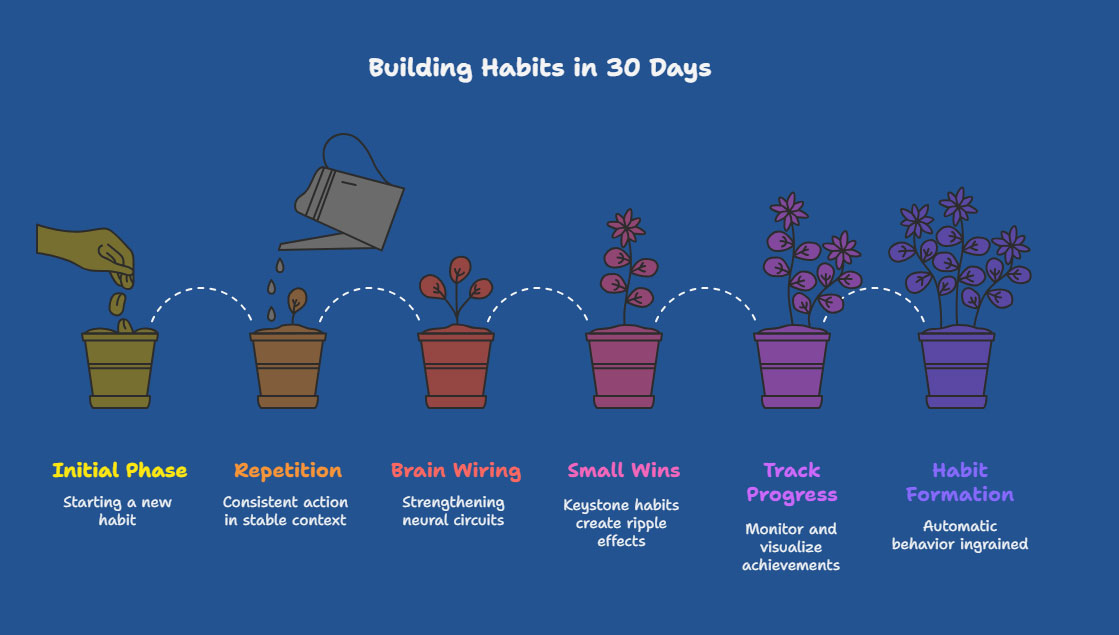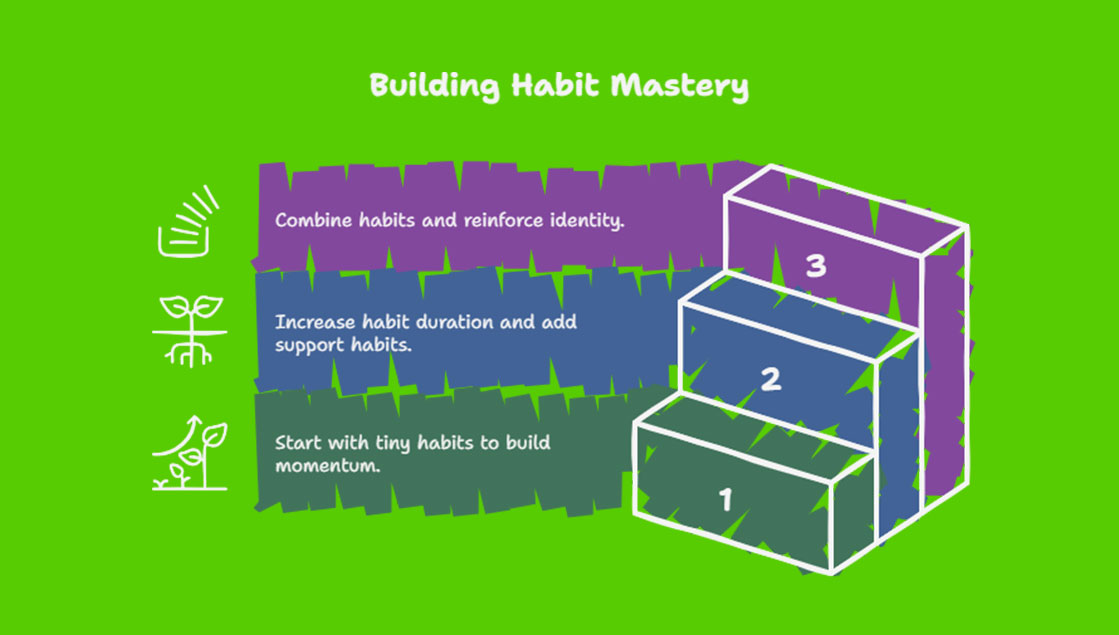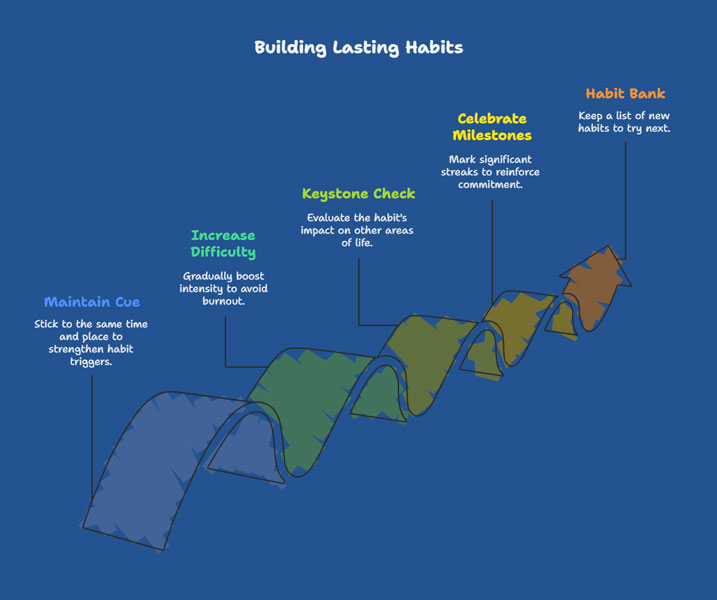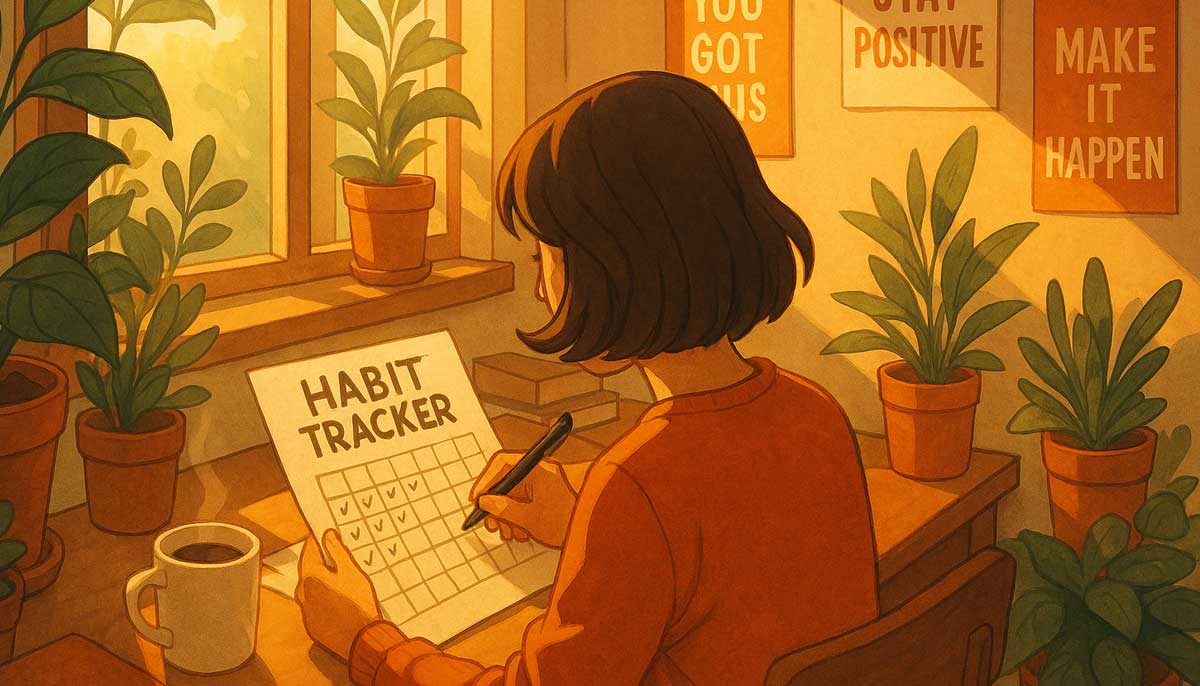You don’t need a 5 a.m. routine or a massive lifestyle overhaul to transform your life.
The real magic happens when you commit to one small win at a time — repeated daily until it becomes second nature.
The 30-Day Habit Challenge is your step-by-step blueprint for creating a habit you’ll actually stick with.
It blends science-backed strategies, practical tools, and a printable habit tracker so you can:
• Start small and avoid overwhelm
• Build consistency without burning out
• See visible progress from Day 1
• Turn a single habit into long-term transformation
This isn’t just another “challenge” — it’s a habit system grounded in research from University College London, Scientific American, and habit experts like James Clear and BJ Fogg.
Why 30 Days Works — Science, Not Hype

1. Habits form through repetition in a stable context
When you repeat the same action after the same cue, your brain gradually shifts control from conscious effort to automatic behavior — a process known as habit automaticity.
A real-world study from University College London found it takes an average of 66 days to fully automate a habit, but 30 days is the perfect kick-start to test your system and lock in your routine cues.
(Source: https://onlinelibrary.wiley.com/doi/full/10.1002/ejsp.674).
2. Your brain is wired for habits
Repetition strengthens circuits in the basal ganglia, especially the striatum, which plays a key role in habit memory and skill learning.
Once these circuits are engaged, habits require less mental effort and willpower to execute.
(Source: https://www.scientificamerican.com/article/power-of-habit-excerpt/).
3. Small wins create big ripple effects
A single “keystone habit” — like daily movement, journaling, or morning planning — can positively influence other areas of life.
For example, people who start exercising regularly often naturally improve their diet and sleep without actively focusing on those areas.
(Source: https://charlesduhigg.com/the-power-of-habit/).
4. Trackers and streaks boost motivation
Visible progress keeps you engaged. The “don’t break the chain” method, where you mark each completed day, leverages the motivational power of streaks and gamification.
Health behavior research shows that tracking and visual feedback significantly increase habit adherence.
(Source: https://www.frontiersin.org/articles/10.3389/fpsyg.2019.00539/full).
How to Start Your 30-Day Habit Challenge (5 Steps)
1. Pick One Focus Habit
Ask yourself: “What single change would make the biggest difference in my life right now?”
Choose the first answer that comes to mind — then shrink it to the smallest version you can do in two minutes or less.
Examples:
• Health: After making coffee, drink one glass of water.
• Focus: At 9:00 a.m., complete one 25-minute deep work block.
• Mindset: After brushing teeth, write one gratitude sentence.
• Relationships: After lunch, send one thoughtful message.
Starting small helps build consistency and reduces resistance. (Source: https://jamesclear.com/atomic-habits).
2. Choose Your Mode
• Flexible Mode (recommended): Miss up to two days per week but still aim for 30 total checkmarks.
• Streak Mode: If you miss a day, restart the count. This mode works best for breaking habits like sugar, smoking, or social media overuse.
3. Design Your Cue and Environment
• Habit stacking: Link your new habit to something you already do — a method made popular by Atomic Habits. (Source: https://jamesclear.com/habit-stacking).
• Make it obvious: Place visual reminders in the environment where the habit happens (water bottle on desk, book on pillow).
• Make it easy: Reduce friction by preparing what you need in advance (lay out workout clothes, bookmark your journal app).
• Make it satisfying: End with a quick reward (check a box, fist pump, short message to an accountability partner).
4. Track It Visibly
• Use the Printable 30-Day Habit Tracker and place it somewhere you’ll see multiple times per day.
• Alternatively, use streak-based habit apps like Streaks, Habitica, or Done — research supports that visible progress boosts adherence.
5. Add Light Accountability
Tell a friend, family member, or online group your goal and update them weekly.
Even low-pressure accountability increases the likelihood of following through.
Ready-Made 30-Day Progressions

Swap in your chosen habit — the power comes from the gradual progression, not from doing “more” than necessary.
Beginner (Micro-Habit Momentum)
Ideal if you’ve struggled to stick to habits before or want a zero-stress start.
• Days 1–7: Do the tiniest version (≤2 minutes) right after your chosen cue.
• Days 8–14: Keep the cue; extend to 5 minutes.
• Days 15–21: Add a quick reward — note your mood or energy in one sentence.
• Days 22–30: Remove one friction point each day (prep gear, clear workspace, schedule reminder).
Small, consistent actions after stable cues help habits form faster.
Intermediate (Consistency + Capacity)
Perfect if you already have a small routine and want to level up.
• Days 1–5: Tiny habit daily (≤2 minutes).
• Days 6–10: Standard version of the habit (e.g., 10-minute workout).
• Days 11–15: Add a support habit (e.g., water before exercise, meditation before journaling).
• Days 16–20: Introduce variety to prevent boredom (new walking route, different recipe, new playlist).
• Days 21–30: Fix the habit to the same time and place to strengthen cue associations.
Advanced (Stacking Without Overwhelm)
Designed for those already confident in habit consistency who want to stack multiple gains.
• Daily: Complete your core habit + one micro-stack (e.g., pushups → stretching, journaling → affirmations).
• Weekly: Take one planned rest or review day to reflect and adjust.
• Days 22–30: Add a one-line identity statement reinforcing your self-image (“I’m the kind of person who keeps promises to myself”).
Stacking related habits together creates a “chain reaction” that strengthens your identity as someone who follows through.
30 Habit Ideas to Try
If you’re not sure where to start, here’s a list of habit ideas organized by life category.
Pick only one to focus on for your first challenge — success comes from consistency, not volume.
Health & Energy habits
1. Drink one glass of water upon waking.
2. Stretch for 5 minutes after your morning coffee.
3. Take a 10-minute walk after lunch.
4. Do 5 pushups after brushing teeth.
5. Eat one extra serving of vegetables daily.
6. Go phone-free 60 minutes before bed.
7. Replace one sugary drink with water or herbal tea.
8. Stand up and move for 2 minutes every hour.
Focus & Productivity habits
9. Do one Pomodoro session at a fixed time daily.
10. Tackle your hardest task before checking email.
11. Check email only once per day.
12. Plan your day the night before.
13. Review top 3 priorities each morning.
14. Spend 10 minutes decluttering your workspace.
15. Read a professional development article daily.
Mindset & Mood habits
16. Write one gratitude sentence each night.
17. Read 10 minutes of non-news content before bed.
18. Take 3 deep breaths before starting work.
19. Journal one page each morning.
20. Practice one minute of mindfulness after lunch.
21. Listen to one uplifting podcast segment daily.
22. Say a positive affirmation each morning.
Relationships & Social habits
23. Send one kind check-in message daily.
24. Give one genuine compliment each day.
25. Eat one meal without any screens.
26. Write a short thank-you note once a week.
27. Call a friend or family member every Sunday.
28. Ask one thoughtful question in conversation daily.
29. Offer help to someone once a week.
30. Share a personal win or lesson with someone you trust.
What to Do if You Miss a Day
Missing a day doesn’t mean you’ve failed — it means you’ve been given feedback.
The key is to course-correct quickly so a one-time slip doesn’t turn into a pattern.
1. Follow the “Never Miss Twice” Rule
It’s perfectly fine to miss once.
But skipping twice in a row greatly increases the chance of losing momentum — and building the wrong pattern. As productivity expert James Clear explains, missing once is an accident, but missing twice is a choice.
2. Diagnose the Real Problem
Ask yourself: Why did I miss it?
• Cue problem: Wrong time/place, habit didn’t get triggered.
• Friction problem: Too many steps or too hard to start.
• Reward problem: The action didn’t feel satisfying.
Identifying the weak link helps you make a targeted fix (Source: https://www.behaviormodel.org/).
3. Restart Small
If you miss, go back to the tiniest version of your habit.
This resets momentum and rebuilds confidence without adding pressure.
4. Treat Misses as Data, Not Drama
High performers view setbacks as useful information, not proof they “can’t” succeed.
You’re not starting over — you’re continuing, with more insight.
After Day 30: Keep the Habit Alive

Finishing the 30-Day Habit Challenge is just the beginning.
The real success comes when your habit becomes so automatic that missing it feels strange.
1. Keep the Same Cue and Environment
Changing your cue too soon can weaken your habit trigger.
Stick to the same time and place for at least 2–3 months after the challenge.
2. Increase Difficulty Gradually
Boost intensity or duration by no more than 10–20% at a time.
This slow progression prevents burnout and keeps the habit enjoyable.
3. Do a Weekly “Keystone Check”
Ask: Is this habit still creating ripple effects in other areas of my life?
If the answer is no, tweak it or replace it with a new high-impact habit.
4. Celebrate Milestones
Mark 60 days, 90 days, and one-year streaks.
Publicly celebrating wins — even in a private journal — strengthens your self-image as someone who keeps promises to themselves.
5. Keep a Habit Bank
Maintain a running list of micro-habits you want to try.
When one habit becomes automatic, pull the next from your “bank” and start another 30-day cycle.
Frequently Asked Questions About the 30-Day Habit Challenge
Can you really form a habit in 30 days?
Not always — and that’s fine.
Research from University College London found it takes an average of 66 days to fully automate a habit, but the range can be anywhere from 18 to 254 days.
Thirty days is a strong launch period to test, refine, and lock in your habit cues.
What if I miss several days in a row?
Don’t quit — reset small.
Figure out whether the issue was your cue (bad timing), friction (too many steps), or reward (not satisfying enough), then adjust that one element before starting again.
Should I track more than one habit at once?
If you’re a beginner, stick to one primary habit until it’s consistent.
Once that habit feels automatic, you can stack another using the habit stacking method.
What’s the best time of day to do my habit?
The “best” time is when you can consistently repeat the habit in the same context daily.
For many people, mornings work because there are fewer distractions — but any consistent time can work.
How do I stay motivated for the full 30 days?
- Track visible progress with a Printable Habit Tracker.
- Pair the habit with a small reward.
- Join a friend or accountability group for extra commitment.
References & Further Reading
These resources provide the science and strategies behind habit formation and 30-day challenges:
• How Are Habits Formed? — European Journal of Social Psychology (https://onlinelibrary.wiley.com/doi/full/10.1002/ejsp.674)
• The Neuroscience of Habits — Scientific American (https://www.scientificamerican.com/article/power-of-habit-excerpt/)
• The Power of Habit — Charles Duhigg (https://charlesduhigg.com/the-power-of-habit/)
• Gamification for Behavior Change — Frontiers in Psychology (https://www.frontiersin.org/articles/10.3389/fpsyg.2019.00539/full)
• Atomic Habits — James Clear (https://jamesclear.com/atomic-habits)
• BJ Fogg’s Behavior Model (https://www.behaviormodel.org/)
Final Takeaway
You don’t need to wait for the “perfect time” to start.
Choose one small habit, commit to it for 30 days, and track your progress.
By the end, you won’t just have a habit — you’ll have proof that you can change your life one small win at a time.








